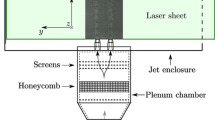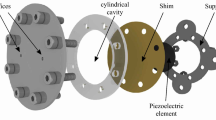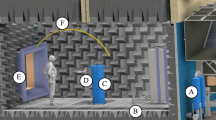Abstract
A twin jet was tested in anechoic facilities at the University of Arizona and NASA Langley Research Center to determine the effectiveness of flexible filaments in jet noise reduction. Results were strongly dependent on filament diameter and material, the most effective of which was found to be Tex 800 Kevlar. In the best configurations, the filaments consistently eliminated screech tones and reduced overall sound pressure level by 3 dB or more. Additionally, broadband shock noise was diminished by more than 5 dB over certain audible frequency ranges. Larger-scale tests run at NASA showed comparable reductions in overall sound pressure level and broadband shock-associated noise.
















Similar content being viewed by others
Abbreviations
- M:
-
Mach number
- SPL:
-
Sound pressure level
- OASPL:
-
Overall sound pressure level
- FFT:
-
Fast Fourier transform
- dB:
-
Decibel SPL, reference: 20 μPa RMS
- f c :
-
Characteristic frequency (jet velocity/exit diameter)
- St:
-
Strouhal number
- df :
-
Frequency resolution
- A :
-
Nozzle cross-sectional area
- D :
-
Single nozzle exit diameter
- L :
-
Filament length (from tip to nozzle exit)
References
Anderson B, Wygnanski I, Gutmark E (1999) Noise reduction by interaction of flexible filaments with an underexpanded supersonic jet. AIAA Paper 99-0080
Bozak R, Henderson B (2011) Aeroacoustic experiments with twin jets, 17th AIAA/CEAS aeroacoustics conference, Portland, OR, AIAA paper 2011–2790
Henderson B, Bridges J (2010) An MDOE investigation of chevrons for supersonic jet noise reduction. 16th AIAA/CEAS aeroacoustics conference, Stockholm, Sweden, AIAA Paper 2010–3926
Hileman JI (2004) Large scale structures and noise generation in high-speed jets. Dissertation, Ohio State University
John JE, Keith TG (2006) Gas dynamics, 3rd edn. Pearson-Prentice Hall, New Jersey
Kantola RA (1981) Acoustic properties of heated twin jets. J Sound Vib 79(1):79–106
Kearney-Fischer M, Kim JH, Samimy M (2009) Noise control of a high reynolds number mach 0.9 heated jet using plasma actuators. 30th AIAA aeroacoustics conference, Miami, FL, AIAA paper 2009–3188
Krothapalli A, Greska B, Arakeri V (2002) High speed noise reduction using microjets. 8th AIAA/CEAS aeroacoustics conference, Breckenridge, CO, AIAA paper 2002–2450
Kuo C-W, Veltin J, McLaughlin DK (2009) Acoustic measurements of models of military style supersonic nozzle jets, 47th AIAA aerospace sciences meeting, Orlando, FL, AIAA Paper 2009–0018
Laurendeau E, Jordan P, Bonnet JP, Delville J, Parnaudeau P, Lamballais E (2008) Subsonic jet noise reduction by fluidic control: the interaction region and the global effect. Phys Fluids 20:101519
Noise Sources (1991) Aeroacoustics of flight vehicles: theory and practice, NASA reference publication 1259, Vol. 1, WRDC Technical Report 90-3052
Powell A (1953) On the mechanism of choked jet noise. Proc Phys Soc Lond 66:1039–10560
Raman G, Kibens V, Cain A, Lepicovsky J (2000) Advanced actuator concepts for active aeroacoustic control. 6th AIAA/CEAS aeroacoustics conference, Lahaina, HI, AIAA Paper 2000–193
Rask O, Kastner J, Gutmark E (2011) Understanding how chevrons modify noise in a supersonic jet with flight effects. AIAA J 49(8):1569–1576
Schlinker RH, Simonich JC, Reba RA (2011) Flight effects of supersonic jet noise from Chevron Nozzles. 17th AIAA/CEAS aeroacoustics conference, Portland, OR, AIAA Paper 2011–2703
Simonich JC, Amiet RK, Schlinker RH (1986) Jet shielding of jet noise. NASA contractor report 3966
Zakharin B, Kit E, Wygnanski I (2009) On a turbulent mixing layer created downstream of a ‘Λ’ notch simulating one wavelength of a Chevron Nozzle. Flow Turbulence Combust 83:371–388
Acknowledgments
We would like to acknowledge the assistance of Dr. Jesse Little, who was very helpful in making sure the results and background information were framed in the proper context with respect to other aeroacoustics research that has been done in the past, and Philipp Tewes, who contributed to the data processing effort. Many thanks to Harry Haskin, John Swartzbaugh, and the rest of the NASA JNL crew for the exciting opportunity to collaborate our research. Funding for the NASA tests from the NASA Langley Research Directorate Office and the Fundamental Aeronautics Program Supersonics Project is gratefully acknowledged.
Author information
Authors and Affiliations
Corresponding author
Additional information
This article is part of the collection Topics in Flow Control. Guest editors J.P. Bonnet and L. Cattafesta.
Rights and permissions
About this article
Cite this article
Lucas, N., Doty, M., Taubert, L. et al. Reducing the noise emanating from a twin jet nozzle using flexible filaments. Exp Fluids 54, 1504 (2013). https://doi.org/10.1007/s00348-013-1504-8
Received:
Revised:
Accepted:
Published:
DOI: https://doi.org/10.1007/s00348-013-1504-8




